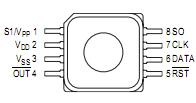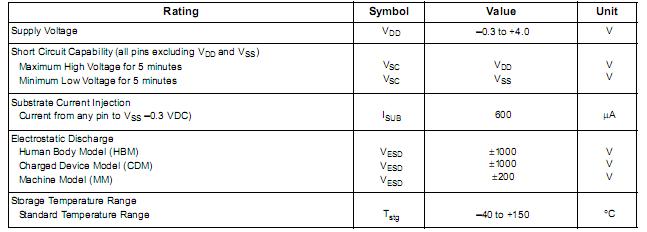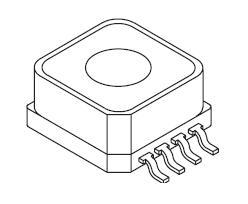Pinout Specifications
Specifications
 Description
DescriptionThe block diagram of the MPXY8000 series sensor is shown in Figure 1. The
pressure sensor is a capacitive transducer constructed using surface
micromachining, the temperature sensor is constructed using a diffused
resistor, and the interface circuit is integrated onto the same die as the sensors
using a standard silicon CMOS process.
The MPXY8000 conditioning of the pressure signal begins with a capacitance to voltage
conversion (C to V) followed by a switched capacitor amplifier. This amplifier
has adjustable offset and gain trimming. The offset and gain are factory
calibrated, with calibration values stored in the EEPROM trim register. This
amplifier also has temperature compensation circuits for both sensitivity and
offset, which also are factory adjusted using the EEPROM trim register.
The pressure is monitored by a voltage comparator, which compares the
measured value against an 8-bit threshold adjusted by a serial input. By
adjusting the threshold and monitoring the state of the OUT pin the external
device can check whether a low-pressure threshold has been crossed, or
perform up to 8-bit A/D conversions.
The MPXY8000 temperature is measured by a diffused resistor with a positive
temperature coefficient driven by a current source, thereby creating a voltage.
The room temperature value of this voltage is factory calibrated using the
EEPROM trim register. A two-channel multiplexer can route either the pressure
or temperature signal to a sampling capacitor that is monitored by a voltage
comparator with variable threshold adjust, providing a digital output for
temperature.
An internal low frequency, MPXY8000 low power 5.4 kHz oscillator with a 14-stage
divider provides a periodic pulse to the OUT pin (divide by 16384 for 3 seconds).
This pulse can be used to wake up an external MCU to begin an interface with
the device. An additional 10-stage divider will provide a pulse every 52 minutes
which can be used to reset an external MCU.
The MPXY8000 power consumption can be controlled by several operational modes
selected by external pins.

 MPXY8000 Data Sheet
MPXY8000 Data Sheet










